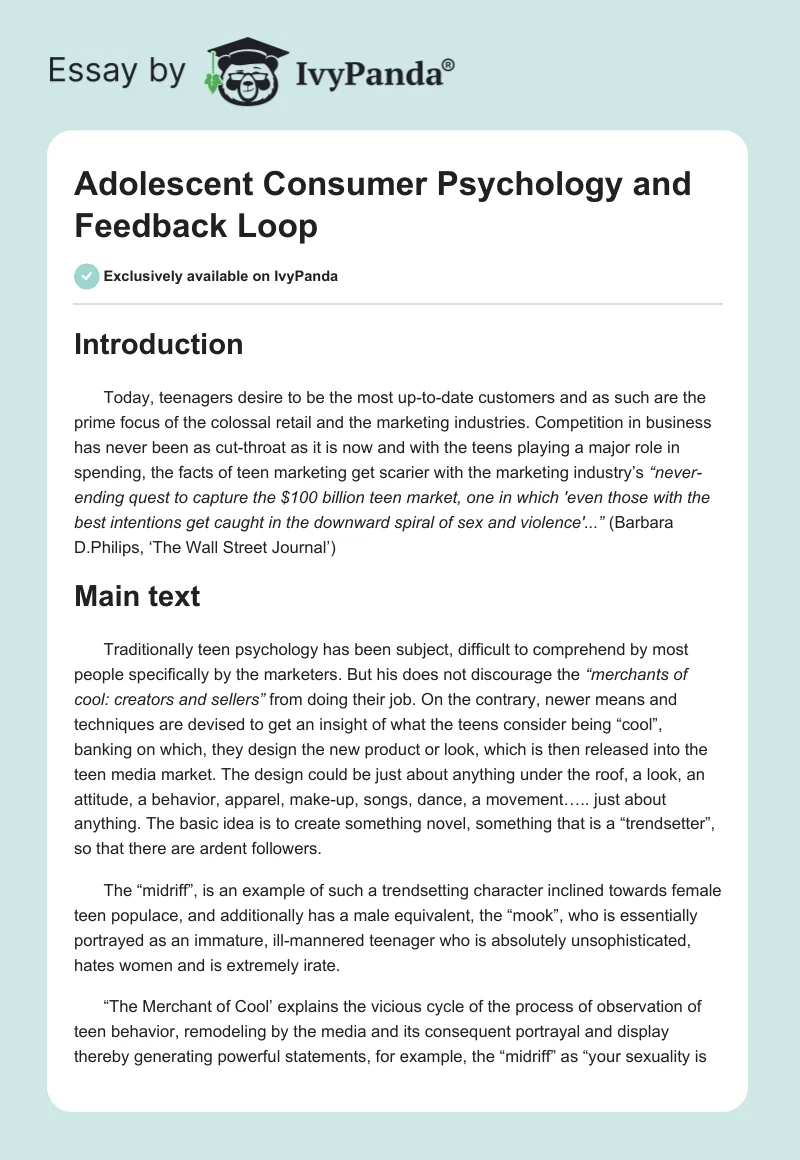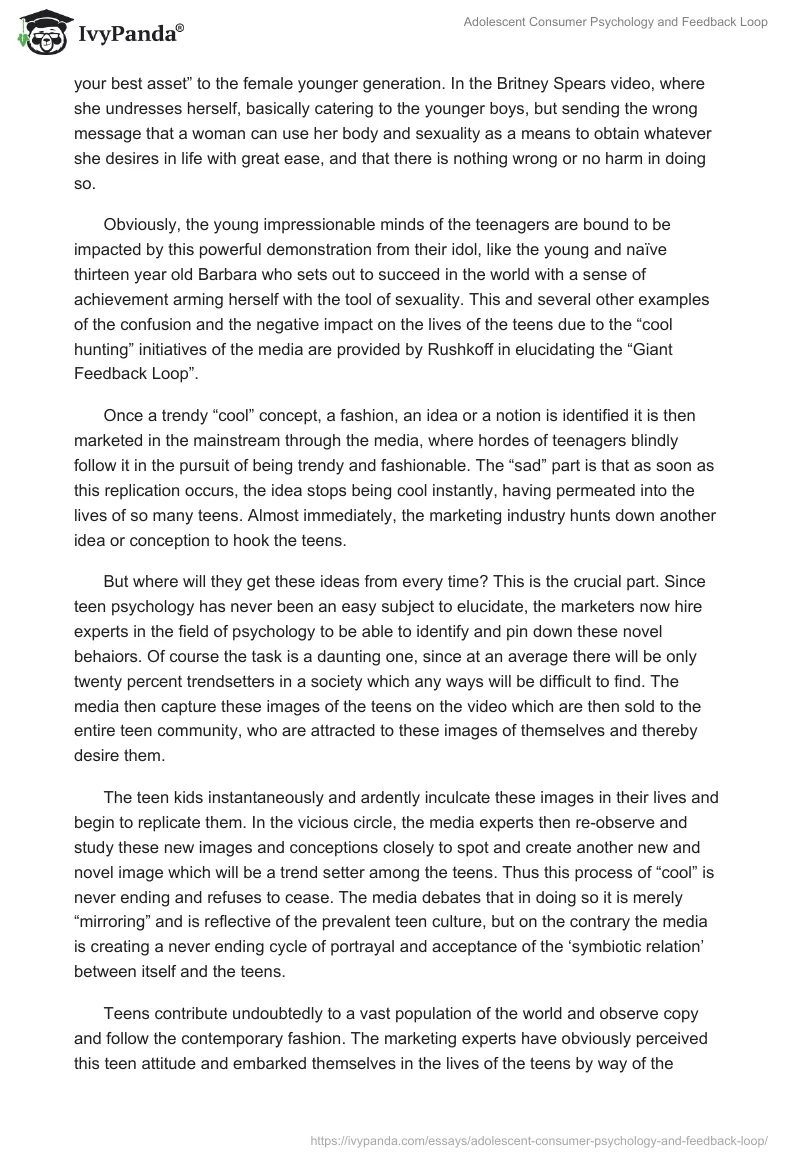Introduction
Today, teenagers desire to be the most up-to-date customers and as such are the prime focus of the colossal retail and the marketing industries. Competition in business has never been as cut-throat as it is now and with the teens playing a major role in spending, the facts of teen marketing get scarier with the marketing industry’s “never-ending quest to capture the $100 billion teen market, one in which ‘even those with the best intentions get caught in the downward spiral of sex and violence’…” (Barbara D.Philips, ‘The Wall Street Journal’)
Main text
Traditionally teen psychology has been subject, difficult to comprehend by most people specifically by the marketers. But his does not discourage the “merchants of cool: creators and sellers” from doing their job. On the contrary, newer means and techniques are devised to get an insight of what the teens consider being “cool”, banking on which, they design the new product or look, which is then released into the teen media market. The design could be just about anything under the roof, a look, an attitude, a behavior, apparel, make-up, songs, dance, a movement….. just about anything. The basic idea is to create something novel, something that is a “trendsetter”, so that there are ardent followers.
The “midriff”, is an example of such a trendsetting character inclined towards female teen populace, and additionally has a male equivalent, the “mook”, who is essentially portrayed as an immature, ill-mannered teenager who is absolutely unsophisticated, hates women and is extremely irate.
“The Merchant of Cool’ explains the vicious cycle of the process of observation of teen behavior, remodeling by the media and its consequent portrayal and display thereby generating powerful statements, for example, the “midriff” as “your sexuality is your best asset” to the female younger generation. In the Britney Spears video, where she undresses herself, basically catering to the younger boys, but sending the wrong message that a woman can use her body and sexuality as a means to obtain whatever she desires in life with great ease, and that there is nothing wrong or no harm in doing so.
Obviously, the young impressionable minds of the teenagers are bound to be impacted by this powerful demonstration from their idol, like the young and naïve thirteen year old Barbara who sets out to succeed in the world with a sense of achievement arming herself with the tool of sexuality. This and several other examples of the confusion and the negative impact on the lives of the teens due to the “cool hunting” initiatives of the media are provided by Rushkoff in elucidating the “Giant Feedback Loop”.
Once a trendy “cool” concept, a fashion, an idea or a notion is identified it is then marketed in the mainstream through the media, where hordes of teenagers blindly follow it in the pursuit of being trendy and fashionable. The “sad” part is that as soon as this replication occurs, the idea stops being cool instantly, having permeated into the lives of so many teens. Almost immediately, the marketing industry hunts down another idea or conception to hook the teens.
But where will they get these ideas from every time? This is the crucial part. Since teen psychology has never been an easy subject to elucidate, the marketers now hire experts in the field of psychology to be able to identify and pin down these novel behaiors. Of course the task is a daunting one, since at an average there will be only twenty percent trendsetters in a society which any ways will be difficult to find. The media then capture these images of the teens on the video which are then sold to the entire teen community, who are attracted to these images of themselves and thereby desire them.
The teen kids instantaneously and ardently inculcate these images in their lives and begin to replicate them. In the vicious circle, the media experts then re-observe and study these new images and conceptions closely to spot and create another new and novel image which will be a trend setter among the teens. Thus this process of “cool” is never ending and refuses to cease. The media debates that in doing so it is merely “mirroring” and is reflective of the prevalent teen culture, but on the contrary the media is creating a never ending cycle of portrayal and acceptance of the ‘symbiotic relation’ between itself and the teens.
Teens contribute undoubtedly to a vast population of the world and observe copy and follow the contemporary fashion. The marketing experts have obviously perceived this teen attitude and embarked themselves in the lives of the teens by way of the ‘feedback loop’. The feedback loop is an interconnected incessant process between the teens and the media involving the sharing of surveillance, ideas and apprehension of the “cool” concept, which marketers put to effective use, thereby influencing the teens to accept certain values. The Night parties are a popular form of culture practiced by the American teens, where they get the chance of displaying their cool image and gaining popularity by doing so. Ironically, it is these parties and such events that provide the media with the material they require in order to keep themselves in business.
The parties and get-togethers have thus become a popular hub for the two inter-dependent entities, one providing the other. The cycle never ceases as more and more kids are trapped in the psychological game of being accepted as ‘cool’, a concept which has penetrated the deepest sections of the teen society and even confuses kids into ‘Branding’ themselves by means of the brand they use in their daily lives. The teens, heavily impacted by these ideas, believe that activities such as tattoos and piercing their tongues and eyebrows are indeed the ‘in thing’.
Conclusion
Thus we see the negative influence of the media in fashioning these impressionable minds that are actually the future of a nation. As such the media should adopt a more responsible role, elevated from the economics of the game in order to positively shape the minds of the youth who undoubtedly are the future of any country.
References
Philips D.B., ‘The Wall Street Journal’. Web.


